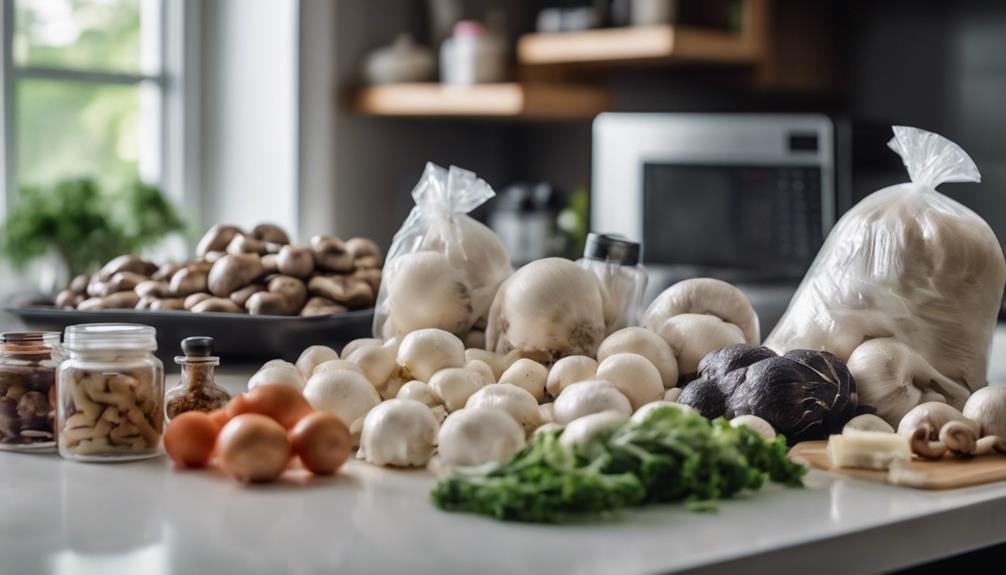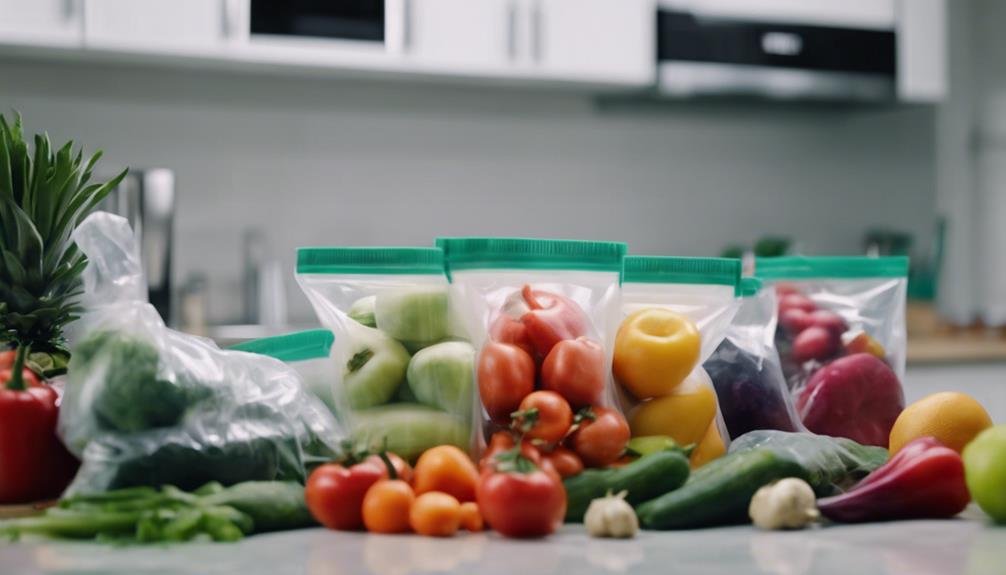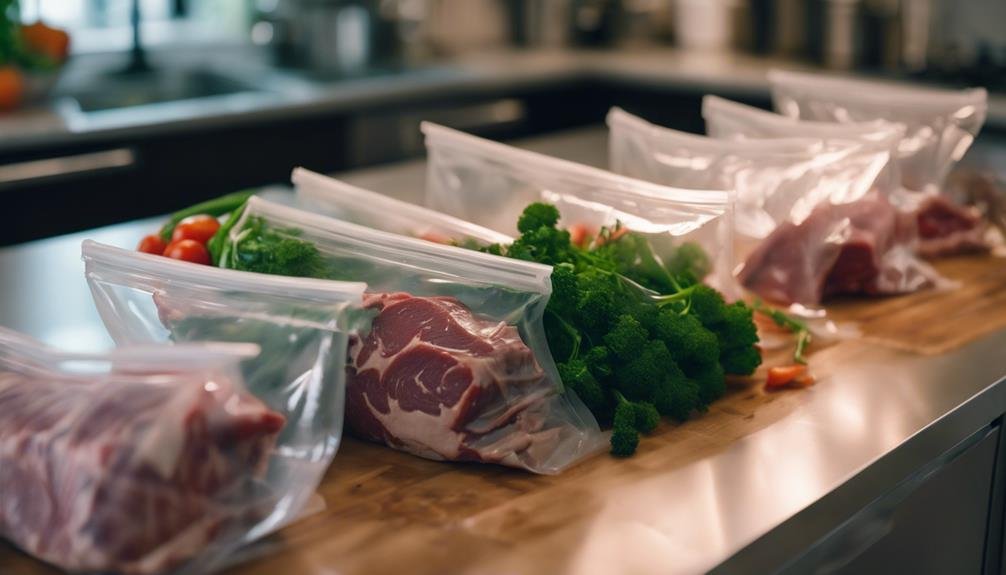If you're new to vacuum sealing, start by selecting the right bags and leaving some space at the top. Freeze liquids before sealing them. Avoid sealing soft cheeses and bananas. Use chamber vacuum sealers for wet foods and external sealers for dry goods. The benefits include extending shelf life, preventing freezer burn, and reducing waste. Handy accessories like jar sealers and bottle stoppers can enhance your experience. Cooking sous vide with vacuum-sealed bags ensures delicious, perfectly cooked meals. You'll find the process straightforward and rewarding. Ready to discover more ways to elevate your food preservation and cooking techniques?
How to Use a Vacuum Sealer
To get started with your vacuum sealer, pick the right bags and leave some space between the food and the bag's top. This space is essential for guaranteeing a proper seal. Next, align the bag with the seal bar inside your vacuum sealer. It's important to make sure the bag is positioned correctly to avoid any issues during the sealing process. Once the bag is in place, tightly close the lid of the vacuum sealer.
Initiate the sealing process by pressing the appropriate button on your machine. The vacuum sealer will then start to remove air from the bag and seal it. You'll need to wait for the machine to complete this process before handling the bag. It usually takes just a few moments.
Watching step-by-step tutorial videos can be incredibly helpful. They'll show you the proper techniques to guarantee your food is vacuum sealed correctly. Don't forget to follow the manufacturer's instructions specific to your vacuum sealer model. This will help you achieve the best results and make sure your vacuum-sealed food stays fresh for longer. Remember, a properly sealed bag is key to preserving your food's quality.
Vacuum Sealing Liquids
Vacuum sealing liquids might seem tricky, but with the right techniques and equipment, you can do it efficiently and mess-free. One effective approach is using chamber machines, which are designed to handle liquids without causing spillage. These machines create a strong seal in vacuum seal bags, guaranteeing your liquids remain intact and fresh.
If you're using an external vacuum sealer, you'll want to freeze your liquids first. This prevents the liquid from being sucked out during the sealing process. Here's a quick guide to help you:
- Freeze Liquids First: Place liquids in vacuum seal bags and freeze them before sealing.
- Use Chamber Machines: Ideal for direct sealing, preventing spillage and ensuring a strong seal.
- Invest in Bottle Stoppers: These accessories help seal liquids in bottles, enhancing efficient storage.
- Label and Date: Always label and date your sealed liquids to keep track of freshness.
Vacuum sealing liquids not only helps in spillage prevention but also extends their shelf life, keeping them fresh for longer periods. By following these steps, you can guarantee efficient storage and maintain the quality of your liquids effortlessly.
Foods to Avoid

When considering vacuum sealing, it is crucial to know which foods to avoid to prevent spoilage or health risks. Some foods simply don't fare well under vacuum sealing conditions and can spoil food rather than preserving it. Soft cheeses like brie or camembert, for instance, have a delicate texture that can be compromised, leading to a less-than-ideal shelf life.
Mushrooms are another food to keep off your vacuum sealing list. They contain moisture that promotes bacteria growth when deprived of air, which not only spoils food but also poses a health risk. Similarly, bananas don't handle the lack of oxygen well and can spoil quickly, losing their texture and flavor.
Foods high in natural oils, like avocados, also suffer from vacuum sealing. The process can make them mushy and unappetizing, reducing their shelf life rather than extending it. Lastly, avoid vacuum sealing garlic. Its anaerobic nature can encourage the development of botulism, a dangerous bacteria that thrives without exposure to air.
Types of Vacuum Sealers
Explore the different types of vacuum sealers to find the best fit for your food preservation needs. There are two main types: chamber vacuum sealers and external vacuum sealers. Understanding their differences will help you determine which one suits your specific storage methods.
Chamber vacuum sealers are a top choice for professional food service environments. They excel at sealing wet foods like soups and marinades due to their ability to control pressure within the chamber. This results in a stronger, more reliable airtight seal. Additionally, they can handle a variety of foods and are versatile enough for marinating needs. However, they tend to be larger and more expensive.
External vacuum sealers, on the other hand, are compact, affordable, and perfect for home use. They work well with dry goods like meats and cheeses. These sealers remove air only from the bag and require special textured bags to aid in the sealing process. While not as versatile as chamber vacuum sealers, they're great for everyday use.
Here's a quick comparison:
- Chamber Vacuum Sealers: Ideal for wet foods, versatile, strong seal.
- External Vacuum Sealers: Best for dry goods, compact, and affordable.
- Chamber Vacuum Sealers: Common in professional kitchens.
- External Vacuum Sealers: Suitable for home use, requires textured bags.
Benefits of Vacuum Sealing

You'll find that vacuum sealing greatly extends the shelf life of your groceries by removing air that causes spoilage. This simple process protects food from freezer burn, ensuring it stays fresh and flavorful much longer. By using a vacuum sealer, you can extend your foods' life up to five times compared to traditional storage methods. Imagine opening your freezer and finding your food in the same condition as when you sealed it—what a difference that can make!
Not only does vacuum sealing protect food, but it's also a real food saver. You'll reduce waste by preserving leftovers and bulk purchases, saving both time and money. Meal prepping becomes a breeze when you can seal food in advance, knowing it will stay fresh until you're ready to use it.
Additionally, vacuum sealing enhances the flavor and texture of your meals, especially when using methods like sous vide or boiling. When you seal food, you lock in all the goodness, making every bite as delicious as the first. So, whether you're a seasoned chef or a beginner, vacuum sealing is an invaluable tool for your kitchen.
Vacuum Sealer Accessories
To enhance your vacuum sealing game, you'll find a range of accessories that make the process even more efficient and versatile. These vacuum sealer accessories can help you achieve airtight seals and extend the shelf life of your food. Let's explore some essential tools you should consider:
- Bag Sealers: These are vital for ensuring that the vacuum sealer bags are tightly closed. They provide a secure seal to keep air out and freshness in.
- Jar Sealers: Perfect for those who want to vacuum seal jars of sauces, jams, or dry goods. Jar sealers create an airtight seal on canning jars, extending the life of your preserves.
- Bottle Stoppers: If you enjoy wine or other bottled beverages, bottle stoppers are a must-have. They fit into the bottle opening and create a vacuum seal to keep your drinks fresh longer.
- Bone Guards: Essential for sealing sharp or pointed foods like meats with bones. Bone guards prevent punctures in vacuum sealer bags, ensuring a tight seal.
Additionally, custom-sized rolls are incredibly useful. These rolls let you cut bags to your desired length, providing flexibility and reducing waste. By incorporating these vacuum sealer accessories, you'll optimize your sealing process and make food storage a breeze.
Cooking With Vacuum Sealed Bags

Cooking with vacuum sealed bags offers a precise and flavorful way to prepare your meals, from tender meats to vibrant vegetables. The technique, known as sous vide, involves cooking food in a precisely controlled water bath. By sealing the food in the bag, you safeguard it from losing its natural juices and flavors, guaranteeing every bite is delicious and tender.
Sous vide cooking is remarkably easy to use. You simply place your seasoned food in the vacuum sealed bag, remove the air, and immerse the bag in a water bath set to your desired temperature. This method helps make perfectly cooked meals by maintaining consistent temperatures, which results in evenly cooked dishes with minimal nutrient loss. Whether you're cooking a juicy steak, delicate fish, or even crisp vegetables, sous vide ensures everything is cooked to perfection.
Additionally, vacuum sealed bags are great for marinating meats. The airtight seal allows flavors to penetrate the food more effectively, speeding up the marinating process. This versatile cooking method can be applied to a wide range of dishes, making it a valuable tool in any kitchen. Try sous vide, and you'll see how easy and rewarding cooking with vacuum sealed bags can be.
Conclusion
Just like sealing a time capsule, vacuum sealing preserves your food's freshness and flavor, locking away precious moments to be enjoyed later. You've learned the ropes of using a vacuum sealer, the do's and don'ts, and the accessories that make it all easier. Embrace this technique and let it be the key to a more efficient kitchen. Your culinary adventures are now set to be timeless treasures, ready to be unwrapped whenever you choose.
